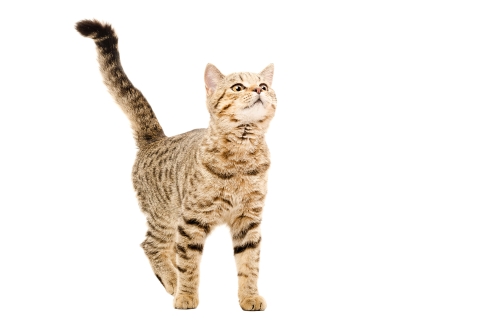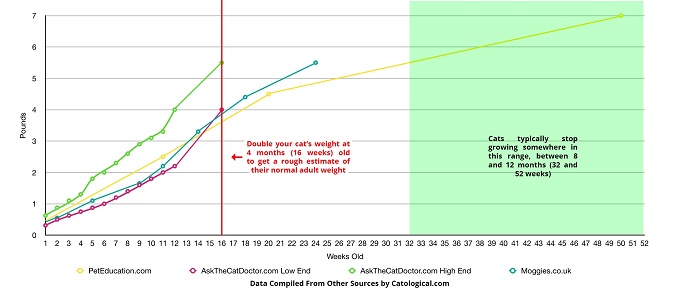Cats come in all sizes. Big cats, little cats, stocky cats, thin cats and everything in between. A lot of how big a cat will get depends on what breed they are, the nutrition they get, their environment and things of that nature.
Speaking of nutrition, that’s a variable that must be mentioned when talking about cats reaching their full size. Let’s not confuse girth with a normal length size for a cat, because overweight or obese cats can be extremely heavy, even as their overall length doesn’t increase. You can see the same characteristic in humans.
If someone is 6 feet tall, no matter how much they weigh, they are still going to be 6 feet tall, which is their regular “size.”
So to that end, let’s explore when a cat reaches their full size.
At What Age Do Cats Stop Growing?

A cat is said to reach adulthood at about 12 months of age. That means their personality has been locked into place, but that doesn’t mean that they will stop growing. Cats generally continue growing until they are 18 months old and reach their full size, but, and this is a big but, larger breeds like Maine Coon cats can grow for up to 5 years!
It gets even more confusing because if your cat has any Maine Coon DNA in its genes, even if it looks like a regular tabby, Siamese, shorthair or whatever, it may continue growing for years after the 18 month mark.
Cat Growth Chart

Nutrition

When Do Cats Grow Full Size?
Cats that are fed normally and who get enough to eat, will adhere to that 18 month full size dictum. But cats that have not gotten enough to eat or have not received proper nutrition, especially when they were kittens, may reach their full size prematurely or become stunted.
Also Read: Best Kitten Food – Top 5 Best Kitten Foods On the Market Today
Abandoned cats are some of the most common stunted felines, and if you get your cat from a shelter, the chances are that it was abandoned and may never be as large as the breed’s potential. It also means that it may stop growing far sooner than normal, since its body had to shut down the growth process for survival.
You can give it all the love, kindness, care and food that you want, but if the growth process has already been shut down by the lack of nutrition, your kitty may not get any bigger than it is at that time.
Spaying And Neutering
Until recently, the size of the cat and how long it kept growing once spayed or neutered was always just a myth. The latest scientific findings shed some light on the subject of growth when those procedures are performed.
It has often been said that a spayed or neutered cat will get bigger than a non-altered cat, and findings have borne this out, with an exception. If a cat is spayed or neutered early in life, it will grow larger, both in girth and length. But if the procedures are carried out in adulthood, it will generally grow to the breeds natural size.
A cat that hasn’t undergone these procedures will generally stick to the 18 month growth limit, as long as its DNA is pure.
A cat that has had the procedure done will have a longer bone structure and will continue growing after the 18 month time frame. For how long, no one can say, but spaying and neutering does positively extend the growth time as well as the size.
If you are willing to spend somewhere between $50 to $100, you can get your cat neutered and confirm this for yourselves.

How Long Do Cats Grow For?
In most cases, the definitive answer is 18 months, with Maine Coon cats taking up to 5 years as mentioned. We’ve already included nutrition, spaying and neutering which will affect a cat’s full size, but there are other factors too.
Cats that suffer dwarfism or bone deformities may stop growing and reach their adult size much sooner. On the other end of this spectrum is the latest news about feral cats that sometimes reach over 4 feet long, which is similar to a wild bobcat or lynx.
If somehow this DNA makes it into a domestic cat, which could be very well possible if a female outdoor cat has not been spayed, then who knows at what age they may stop growing and reach full size.
The bottom line here is this – give your kitty a lot of love, feed them quality cat food, and for you and your best purr faced buddy, size will never matter.
About Author
Mary Nielsen founded FelineLiving.net and is a passionate cat lover, blogger, and part-time music teacher. She founded her blog to share her ups and downs of being a pet parent to a bunch of adorable kittens and cats. When she is not playing with them or teaching, you can find her experimenting in the kitchen.








I have an 11 mth kitten WHO HATES THE 10 week kitten we have just brought home, both were originally shelter kittens, how do I encourage the older kitten to tolerate the little one, we are currently putting the wee one in a bedroom when the older one comes inside as she was starting to not come home, but I worry we may be compounding the problem, any ideas?
Cindy, you might appreciate our video on how to introduce two cats to one another! Wishing you and the kitties all the best.
I had read we’re supposed to feed them kitten food until they are 1 year old, but if they aren’t technically done growing, should I keep giving them kitten food until they’re 18 months (or even 5 years if they have Maine coon DNA or are a Manx cat–who can also take up to 5 years to teach full size)?
You can certainly continue feeding them kitten food until they reach adulthood. There are foods formulated for “all life stages”, which have all the nutritional qualities of kitten food but are marketed for both adults and kittens, and these can be used as well.
That’s a great point. I was considering switching to Whole Hearted brand anyway and I know that’s one that does that. Thank you so much for everything you do to help educate cat lovers across the world. Have a great weekend.
I’m at the point where I dislike him and his nasty behaviour. I have never experienced this and have been a pet owner all my life. He has done this from day 1.
Sorry to hear that, Dionne. Can you tell us more about your cat’s behavior? I may be able to direct you to a guide that will help you to resolve these issues.
My 5 month old cat is dangerously biting and scratching and human that comes his way even small children. He was not a stray but the parents were. I got him 12 weeks after birth. The pain is tremendous and I cant take it anymore. He hasn’t been neutered yet but will be and have his 1st shots soon, but I’m thinking of giving him to the animal control
Dionne, it sounds like you’re experiencing some very challenging behavioral issues. I would advise reading this article on aggression in cats. Make sure that his nails are trimmed and/or use nail caps to protect yourself from his claws. Unfortunately, 5 months is a bit late for getting a cat neutered, so you may see some of these behaviors “locked in” as habits rather than as the direct result of his hormonal condition, but having him neutered may also help somewhat. Before surrendering him to animal control, I would make a serious effort to enrich this cat’s environment, help him work off excess energy, and manage any stress in the home. I wish you all the best.
Thanks! I knew maturity was reached at 1 year, but not that growth took one and a half years.
I had two Singapuras. They take two years to mature.
Why does my female cat snap her jaws and teeth when in scratch her back? Is this due to a botched spay?
It’s hard to say—some cats are very uncomfortable having their backs touched, but this may be indicative of a health issue. You may want to ask your veterinarian about this.
Why is the cat growth chart a human growth chart?
Hi Gemma, I’m not sure what you’re referring to. The growth chart in this article is cat-specific. If you could clarify, I’ll be happy to help or make any corrections that are necessary!
This was helpful, thanks!